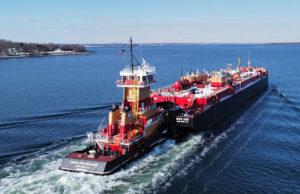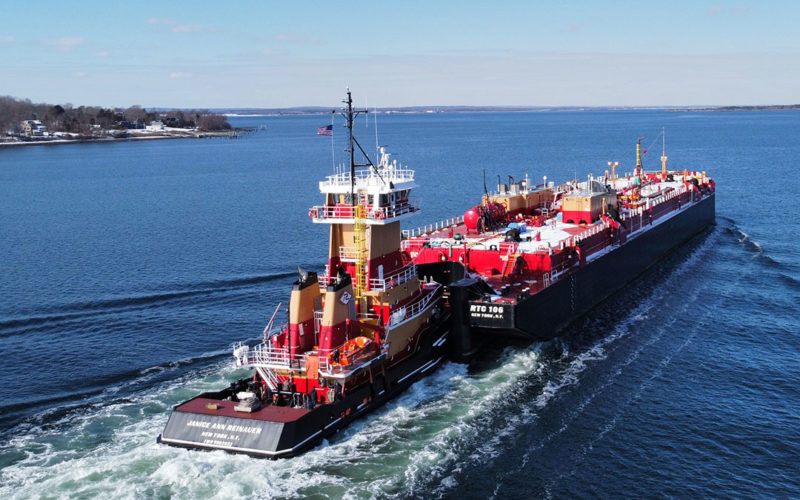
Reinauer Transportation Co. has redesigned its original “facet tug” articulated tug-barge (ATB) for a new era.
Reinauer subsidiary Senesco Marine in North Kingstown, R.I., delivered the 120-foot Janice Ann Reinauer in March 2021. Since leaving the shipyard, the tugboat has paired with several Reinauer tank barges on delivery runs along the Eastern Seaboard.
Janice Ann Reinauer has the same faceted hull design as the original Ruth M. Reinauer built in 2009 but with GE Tier 4 engines requiring a new engine room design. Larger fuel tanks, enhanced steering and numerous smaller tweaks distinguish this ATB tugboat from its six Ruth-class predecessors.
Janice Ann, named for a Reinauer family member, has earned praise for its crew comforts and maneuverability. For an ATB, the tug and barge are surprisingly nimble in close quarters.
“They can turn on a dime pretty well for what they are,” said Chris Reinauer, vice president of the family-run company based in Staten Island, N.Y. “She has independent rudders (and) independent steering. She can twin-screw better than tugs with conventional rudders.”
Reinauer Transportation operates nearly two dozen ATBs in the coastwise trade, half of which feature the faceted hull form that runs from the bulwarks to the keel. Janice Ann Reinauer is the company’s fifth new ATB pusher tug since 2016.
The facet tug design utilizes a straight steel section in the hull and the deckhouse, creating a hard-edged contrast to tugboats and ships with curved hulls. Some have likened the shape, abounding with hard angles, to stealth aircraft.
Robert Hill of Ocean Tug & Barge Engineering developed the facet tug design in the mid-2000s based on a concept that emerged during World War II. The timing coincided with Reinauer’s acquisition of Senesco, prompting a search for a “shipyard-friendly” tugboat design to launch the company’s fleet renewal program. The extensive use of flat paneling shortens construction time and reduces costs.
Subsequent design changes yielded two new facet tug classes, the Twins class and Franklin class, both of which are similar to Ruth M. and its sister tugs but are SOLAS classed. Reinauer operates 12 facet tugs including Janice Ann.
“With the shape of the facet boat, it is not a matter of taking a round hull and carving off hull sections so they are all flat surfaces,” Hill explained. “We try to design the angles between the flat surfaces to optimize them so that we have good water flow over the hull. We have model-tested that until the cows come home.”
Facet tugs are surprisingly capable on their own, Hill said. But they were designed to pair up with tank barges through a pin coupling system. Their performance underway while pushing a barge from the notch is virtually identical to a traditional ATB pusher tug with a curved hull. “We spent a lot of effort getting this right,” he said in a recent interview.
The engine room on Janice Ann Reinauer marks the most significant break with prior Ruth-class tugboats. Propulsion on the older vessels consisted of twin MTU mains generating about 4,700 hp. Those high-speed engines left enough space in the engine area for three 99-kW gensets. Not so on Janice Ann: It is powered by two 2,250-hp medium-speed GE 6L250 mains that are heavier and larger than the MTU units. Just one 99-kW John Deere genset fits between the mains. Two others gensets were installed in the fiddley on the main deck. The 65-kW emergency genset is located halfway up the tower.
Accommodating the larger GE engines was a lot more involved than just swapping out the mains. “It required a complete redesign of the engine room,” Reinauer said. “Everything changes. Your space allowance, your systems on a medium-speed engine are typically off-engine, so it was a completely different boat.
“The rest of the boat is pretty much the same,” he continued. “But let’s face it, a tugboat is basically an engine room with a house wrapped around it.”
Janice Ann and its rotating slate of 100,000-barrel barges pair up through an Intercontinental Model 34 coupler with a star-shaped helmet. The unit is intended to “walk” up the barge ladder as the barge loads or offloads cargo, Reinauer said. It is the first such Intercon helmet system of its kind in the Reinauer fleet.
The full propulsion system on Janice Ann Reinauer, aft of the GE mains, consists of Lufkin reduction gears turning four-blade Pronasa propellers within 104-inch Nautican nozzles. Crews at Senesco Marine assembled the Nautican system.
The tug makes at least 9 knots pushing a loaded barge, and its bollard pull exceeds 72 short tons. Its fuel tanks can hold 127,000 gallons, enabling the vessel to push a loaded barge from New York to Houston and make it at least halfway back without taking fuel.
Reinauer worked with Engine Monitor Inc. (EMI) to develop an independent rudder system that improves maneuverability for the ATB unit. When one engine is moving astern, the rudder on that side centers to optimize thrust. The result is quicker movement and response in tight spaces.
“It has a good power-to-weight ratio, and it seems to handle the barges really well,” Janice Ann Capt. Chris Whitney said. “We have had no issues there. It handles at least as well or better than anything else I have been on.”
Whitney transferred to Janice Ann from Morgan Reinauer, a converted ATB pusher tug on which he worked for nearly three decades. The wheelhouse on the new ATB tug has a 53-foot height of eye, roughly 13 feet higher than on Morgan. “The visibility is outstanding,” Whitney said.
The wheelhouse has three forward steering stations and one facing aft. The navigation electronics include a mix of Furuno and Simrad equipment with a Ritchie compass and Standard Horizon VHF radios. The tug also is equipped with a Furuno GMDSS, as required under SOLAS rules.
Eight CCTV cameras are installed throughout the vessel. The operator can toggle between different views, from the engine room to the aft deck. The latter camera functions like a vehicle backup camera when the tug is moving astern, Whitney said.
On deck, Janice Ann has a staple at the bow forward of an H-bitt. Aft, the tugboat has another H-shaped towing bitt alongside a JonRie InterTech capstan. The second deck has a SOLAS-mandated rescue boat that is raised and lowered by a Global Davit system. Morse Rubber supplied the hull fendering.
Crew spaces on the tugboat’s first and second decks are designed to be comfortable and quiet. Whitney said the Intercon coupler, located forward on the main deck, is surprisingly quiet — even in rolling seas. Resilient-mounted engines and ample insulation further reduce engine noise and vibration.
The deckhouse layout mirrors other ATB tugs in Reinauer’s fleet. There are seven cabins on two decks, and three heads available to the normal contingent of seven crew. The galley and mess rely on stainless-steel surfaces and appliances for ease of maintenance.
Elsewhere, the tugboat retains the character of Ruth M. Reinauer and its sister tugs. Reinauer has standardized the wheelhouse and accommodations spaces across its fleet as much as possible to facilitate crewmembers moving seamlessly between vessels.
Trial and error over many years has led the company to components and systems that reduce downtime. That means redundant systems throughout the vessel, from the third generator to a second wash-water pump to ensure a single fault won’t keep the ATB in port awaiting repairs. On deck, Reinauer uses stainless steel where possible to reduce rust.
The company is always exploring new systems, components and equipment. Chris Reinauer said they look for products or systems offering an advantage.
“Everything is a test,” he said. “We test the newest LEDs, different sanitation systems, different engine manufacturers and we eventually settle on things that give us good reliability and efficiency.”

